Critical Examination of Official Cash Rate and Economic Activity (MBA)
VerifiedAdded on 2022/11/25
|10
|2103
|489
Essay
AI Summary
This essay critically examines the impact of changes in the official cash rate on economic activity in Australia. It begins by defining monetary policy and the role of the Reserve Bank of Australia (RBA) in setting the cash rate to influence aggregate demand, price stability, and employment. The essay explores the monetary transmission mechanism, detailing how changes in the cash rate affect other interest rates, inflation, and overall economic activity, considering Australia's position in the global economy. The analysis includes a review of the RBA's monetary policy decisions in 2010 and 2018, providing justifications for these decisions based on domestic and global economic conditions, including inflation, GDP growth, and the labor market. The essay concludes by summarizing the influence of the cash rate through the monetary transmission mechanism and how it affects economic activity and inflation in Australia.
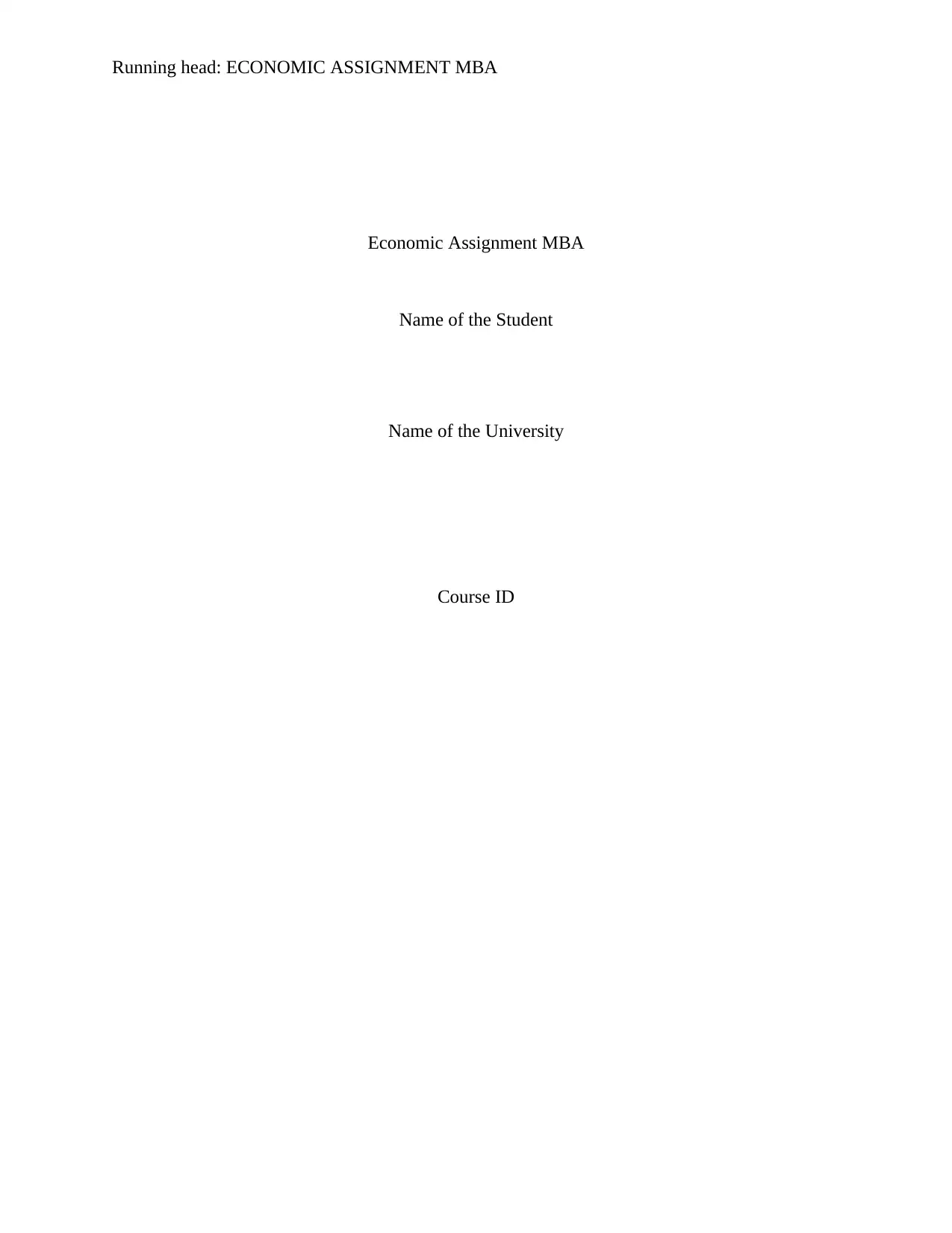
Running head: ECONOMIC ASSIGNMENT MBA
Economic Assignment MBA
Name of the Student
Name of the University
Course ID
Economic Assignment MBA
Name of the Student
Name of the University
Course ID
Paraphrase This Document
Need a fresh take? Get an instant paraphrase of this document with our AI Paraphraser
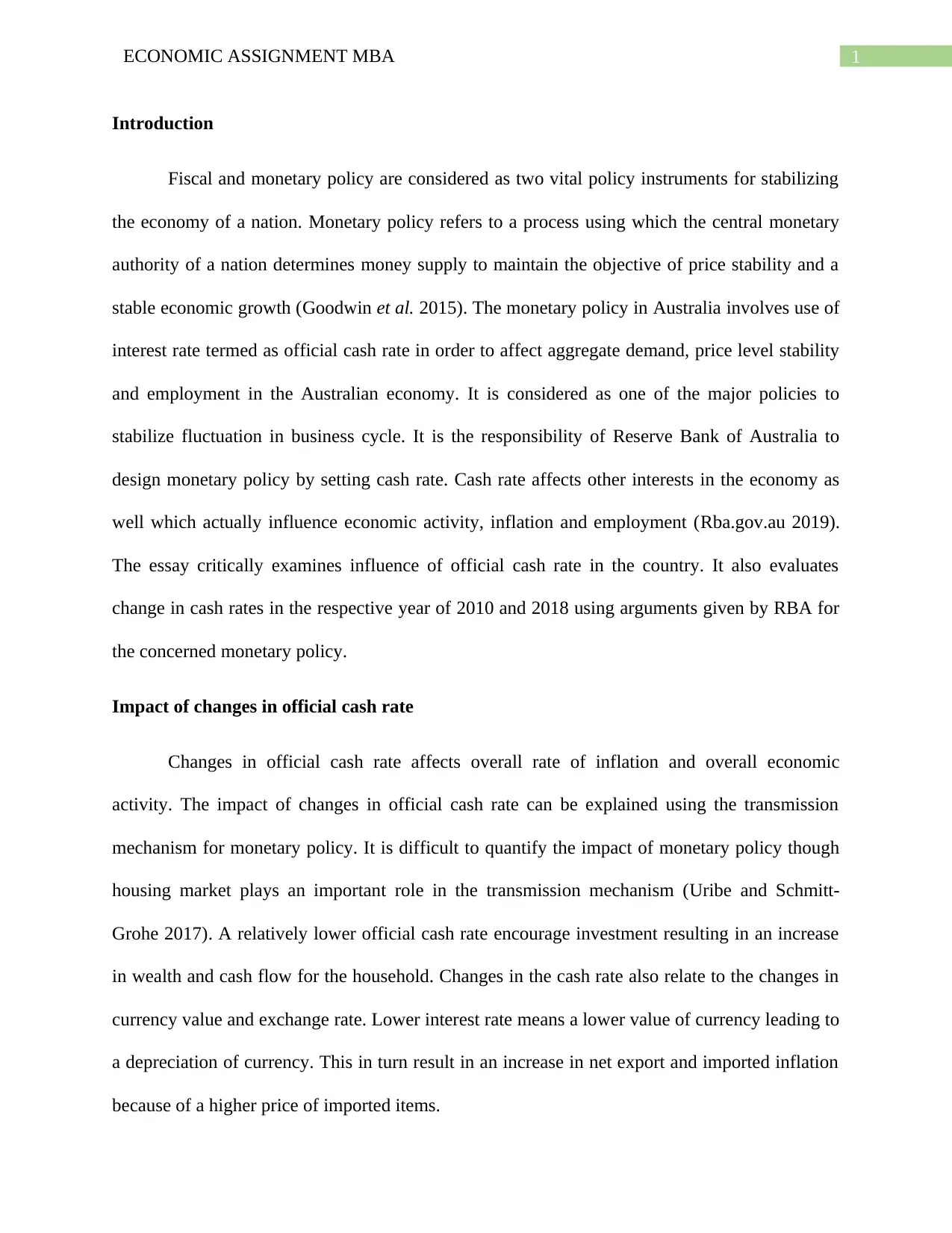
1ECONOMIC ASSIGNMENT MBA
Introduction
Fiscal and monetary policy are considered as two vital policy instruments for stabilizing
the economy of a nation. Monetary policy refers to a process using which the central monetary
authority of a nation determines money supply to maintain the objective of price stability and a
stable economic growth (Goodwin et al. 2015). The monetary policy in Australia involves use of
interest rate termed as official cash rate in order to affect aggregate demand, price level stability
and employment in the Australian economy. It is considered as one of the major policies to
stabilize fluctuation in business cycle. It is the responsibility of Reserve Bank of Australia to
design monetary policy by setting cash rate. Cash rate affects other interests in the economy as
well which actually influence economic activity, inflation and employment (Rba.gov.au 2019).
The essay critically examines influence of official cash rate in the country. It also evaluates
change in cash rates in the respective year of 2010 and 2018 using arguments given by RBA for
the concerned monetary policy.
Impact of changes in official cash rate
Changes in official cash rate affects overall rate of inflation and overall economic
activity. The impact of changes in official cash rate can be explained using the transmission
mechanism for monetary policy. It is difficult to quantify the impact of monetary policy though
housing market plays an important role in the transmission mechanism (Uribe and Schmitt-
Grohe 2017). A relatively lower official cash rate encourage investment resulting in an increase
in wealth and cash flow for the household. Changes in the cash rate also relate to the changes in
currency value and exchange rate. Lower interest rate means a lower value of currency leading to
a depreciation of currency. This in turn result in an increase in net export and imported inflation
because of a higher price of imported items.
Introduction
Fiscal and monetary policy are considered as two vital policy instruments for stabilizing
the economy of a nation. Monetary policy refers to a process using which the central monetary
authority of a nation determines money supply to maintain the objective of price stability and a
stable economic growth (Goodwin et al. 2015). The monetary policy in Australia involves use of
interest rate termed as official cash rate in order to affect aggregate demand, price level stability
and employment in the Australian economy. It is considered as one of the major policies to
stabilize fluctuation in business cycle. It is the responsibility of Reserve Bank of Australia to
design monetary policy by setting cash rate. Cash rate affects other interests in the economy as
well which actually influence economic activity, inflation and employment (Rba.gov.au 2019).
The essay critically examines influence of official cash rate in the country. It also evaluates
change in cash rates in the respective year of 2010 and 2018 using arguments given by RBA for
the concerned monetary policy.
Impact of changes in official cash rate
Changes in official cash rate affects overall rate of inflation and overall economic
activity. The impact of changes in official cash rate can be explained using the transmission
mechanism for monetary policy. It is difficult to quantify the impact of monetary policy though
housing market plays an important role in the transmission mechanism (Uribe and Schmitt-
Grohe 2017). A relatively lower official cash rate encourage investment resulting in an increase
in wealth and cash flow for the household. Changes in the cash rate also relate to the changes in
currency value and exchange rate. Lower interest rate means a lower value of currency leading to
a depreciation of currency. This in turn result in an increase in net export and imported inflation
because of a higher price of imported items.
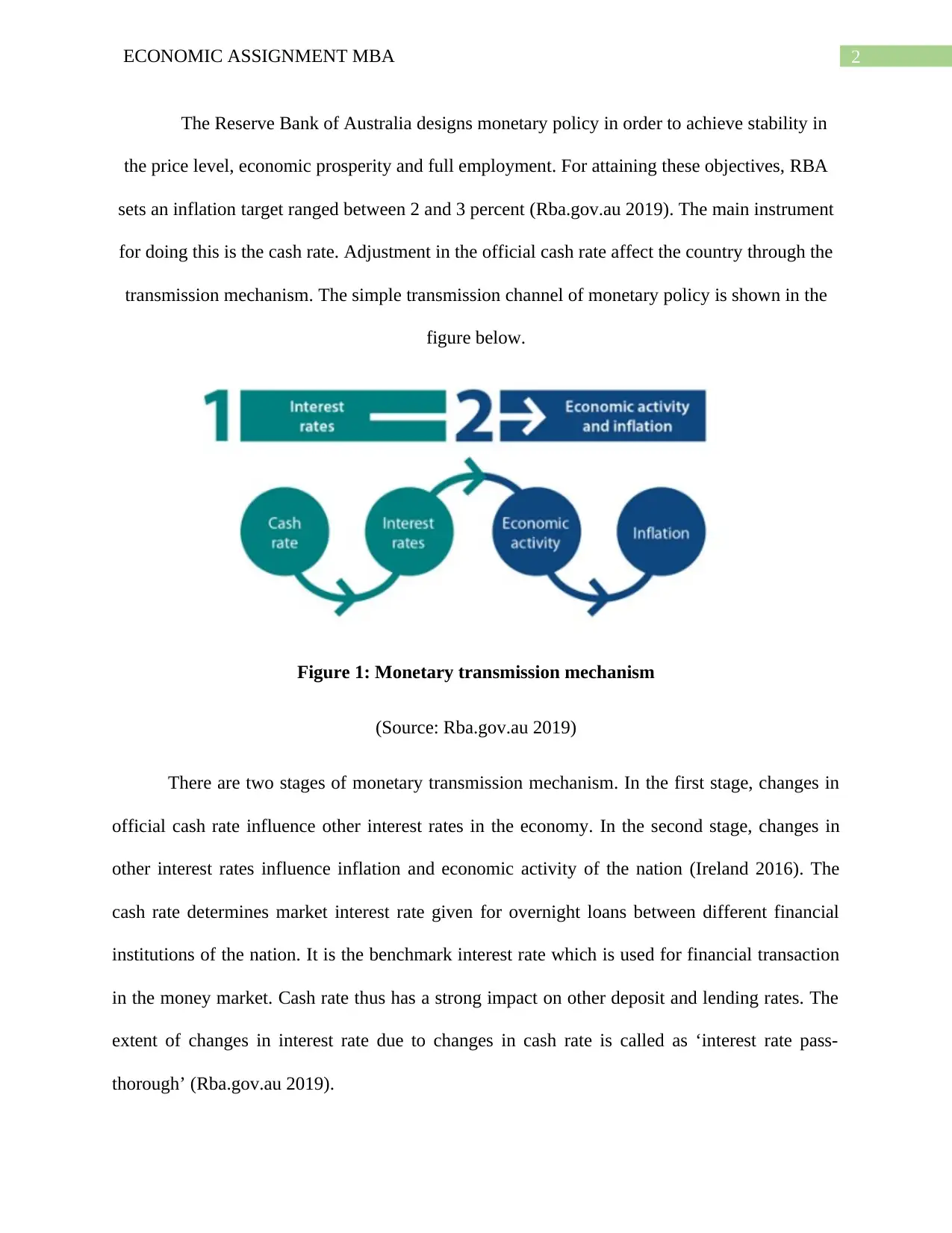
2ECONOMIC ASSIGNMENT MBA
The Reserve Bank of Australia designs monetary policy in order to achieve stability in
the price level, economic prosperity and full employment. For attaining these objectives, RBA
sets an inflation target ranged between 2 and 3 percent (Rba.gov.au 2019). The main instrument
for doing this is the cash rate. Adjustment in the official cash rate affect the country through the
transmission mechanism. The simple transmission channel of monetary policy is shown in the
figure below.
Figure 1: Monetary transmission mechanism
(Source: Rba.gov.au 2019)
There are two stages of monetary transmission mechanism. In the first stage, changes in
official cash rate influence other interest rates in the economy. In the second stage, changes in
other interest rates influence inflation and economic activity of the nation (Ireland 2016). The
cash rate determines market interest rate given for overnight loans between different financial
institutions of the nation. It is the benchmark interest rate which is used for financial transaction
in the money market. Cash rate thus has a strong impact on other deposit and lending rates. The
extent of changes in interest rate due to changes in cash rate is called as ‘interest rate pass-
thorough’ (Rba.gov.au 2019).
The Reserve Bank of Australia designs monetary policy in order to achieve stability in
the price level, economic prosperity and full employment. For attaining these objectives, RBA
sets an inflation target ranged between 2 and 3 percent (Rba.gov.au 2019). The main instrument
for doing this is the cash rate. Adjustment in the official cash rate affect the country through the
transmission mechanism. The simple transmission channel of monetary policy is shown in the
figure below.
Figure 1: Monetary transmission mechanism
(Source: Rba.gov.au 2019)
There are two stages of monetary transmission mechanism. In the first stage, changes in
official cash rate influence other interest rates in the economy. In the second stage, changes in
other interest rates influence inflation and economic activity of the nation (Ireland 2016). The
cash rate determines market interest rate given for overnight loans between different financial
institutions of the nation. It is the benchmark interest rate which is used for financial transaction
in the money market. Cash rate thus has a strong impact on other deposit and lending rates. The
extent of changes in interest rate due to changes in cash rate is called as ‘interest rate pass-
thorough’ (Rba.gov.au 2019).
⊘ This is a preview!⊘
Do you want full access?
Subscribe today to unlock all pages.

Trusted by 1+ million students worldwide
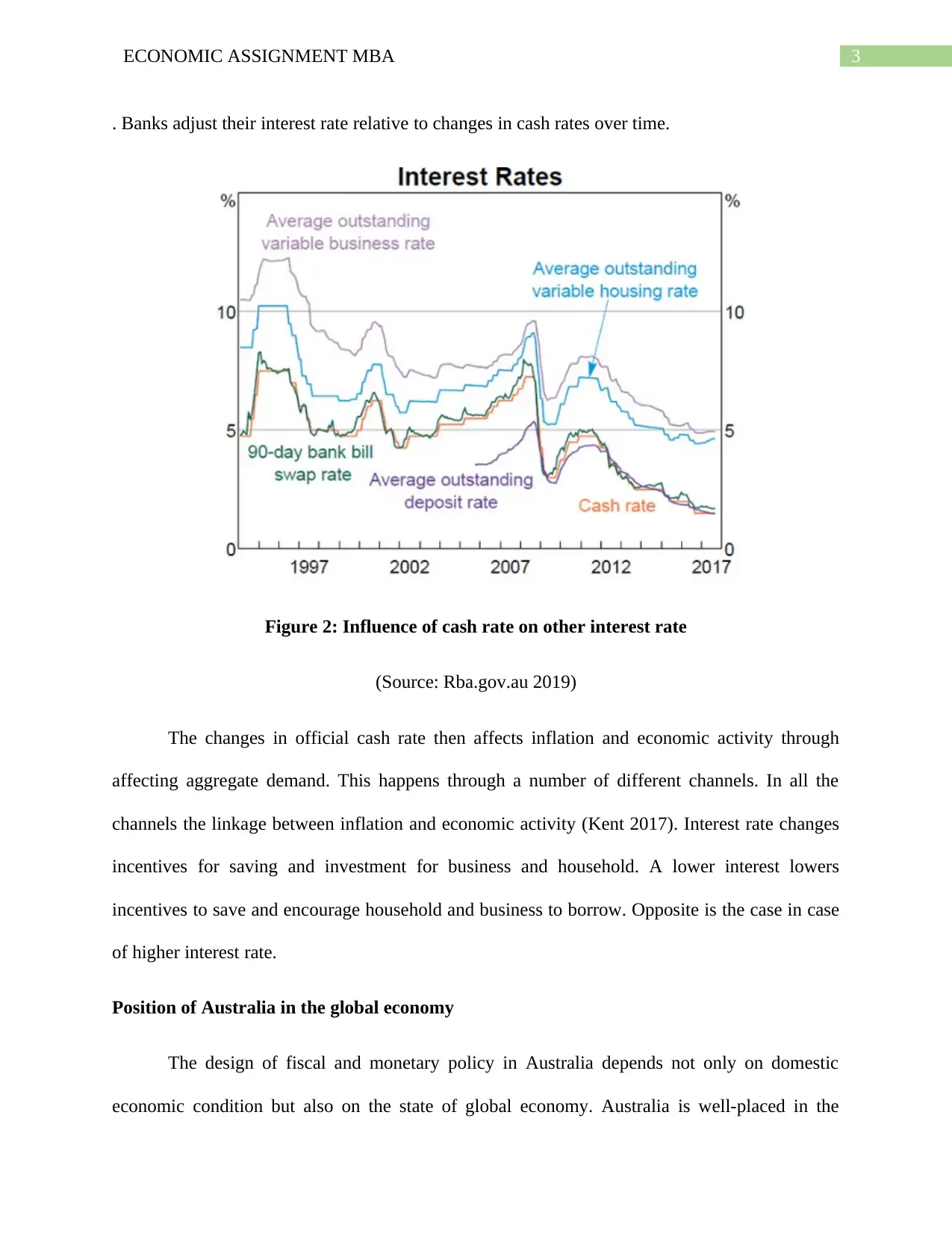
3ECONOMIC ASSIGNMENT MBA
. Banks adjust their interest rate relative to changes in cash rates over time.
Figure 2: Influence of cash rate on other interest rate
(Source: Rba.gov.au 2019)
The changes in official cash rate then affects inflation and economic activity through
affecting aggregate demand. This happens through a number of different channels. In all the
channels the linkage between inflation and economic activity (Kent 2017). Interest rate changes
incentives for saving and investment for business and household. A lower interest lowers
incentives to save and encourage household and business to borrow. Opposite is the case in case
of higher interest rate.
Position of Australia in the global economy
The design of fiscal and monetary policy in Australia depends not only on domestic
economic condition but also on the state of global economy. Australia is well-placed in the
. Banks adjust their interest rate relative to changes in cash rates over time.
Figure 2: Influence of cash rate on other interest rate
(Source: Rba.gov.au 2019)
The changes in official cash rate then affects inflation and economic activity through
affecting aggregate demand. This happens through a number of different channels. In all the
channels the linkage between inflation and economic activity (Kent 2017). Interest rate changes
incentives for saving and investment for business and household. A lower interest lowers
incentives to save and encourage household and business to borrow. Opposite is the case in case
of higher interest rate.
Position of Australia in the global economy
The design of fiscal and monetary policy in Australia depends not only on domestic
economic condition but also on the state of global economy. Australia is well-placed in the
Paraphrase This Document
Need a fresh take? Get an instant paraphrase of this document with our AI Paraphraser
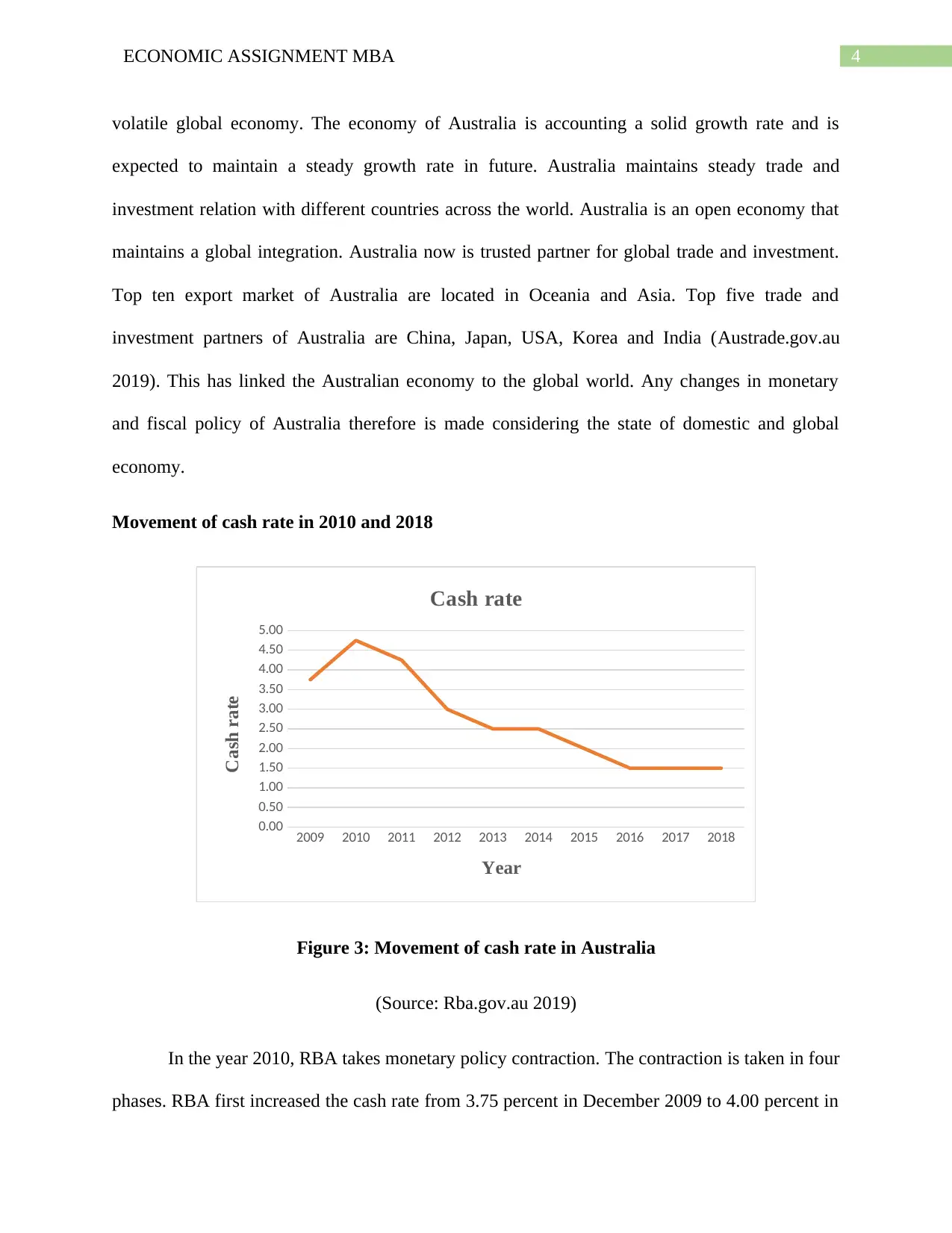
4ECONOMIC ASSIGNMENT MBA
volatile global economy. The economy of Australia is accounting a solid growth rate and is
expected to maintain a steady growth rate in future. Australia maintains steady trade and
investment relation with different countries across the world. Australia is an open economy that
maintains a global integration. Australia now is trusted partner for global trade and investment.
Top ten export market of Australia are located in Oceania and Asia. Top five trade and
investment partners of Australia are China, Japan, USA, Korea and India (Austrade.gov.au
2019). This has linked the Australian economy to the global world. Any changes in monetary
and fiscal policy of Australia therefore is made considering the state of domestic and global
economy.
Movement of cash rate in 2010 and 2018
2009 2010 2011 2012 2013 2014 2015 2016 2017 2018
0.00
0.50
1.00
1.50
2.00
2.50
3.00
3.50
4.00
4.50
5.00
Cash rate
Year
Cash rate
Figure 3: Movement of cash rate in Australia
(Source: Rba.gov.au 2019)
In the year 2010, RBA takes monetary policy contraction. The contraction is taken in four
phases. RBA first increased the cash rate from 3.75 percent in December 2009 to 4.00 percent in
volatile global economy. The economy of Australia is accounting a solid growth rate and is
expected to maintain a steady growth rate in future. Australia maintains steady trade and
investment relation with different countries across the world. Australia is an open economy that
maintains a global integration. Australia now is trusted partner for global trade and investment.
Top ten export market of Australia are located in Oceania and Asia. Top five trade and
investment partners of Australia are China, Japan, USA, Korea and India (Austrade.gov.au
2019). This has linked the Australian economy to the global world. Any changes in monetary
and fiscal policy of Australia therefore is made considering the state of domestic and global
economy.
Movement of cash rate in 2010 and 2018
2009 2010 2011 2012 2013 2014 2015 2016 2017 2018
0.00
0.50
1.00
1.50
2.00
2.50
3.00
3.50
4.00
4.50
5.00
Cash rate
Year
Cash rate
Figure 3: Movement of cash rate in Australia
(Source: Rba.gov.au 2019)
In the year 2010, RBA takes monetary policy contraction. The contraction is taken in four
phases. RBA first increased the cash rate from 3.75 percent in December 2009 to 4.00 percent in
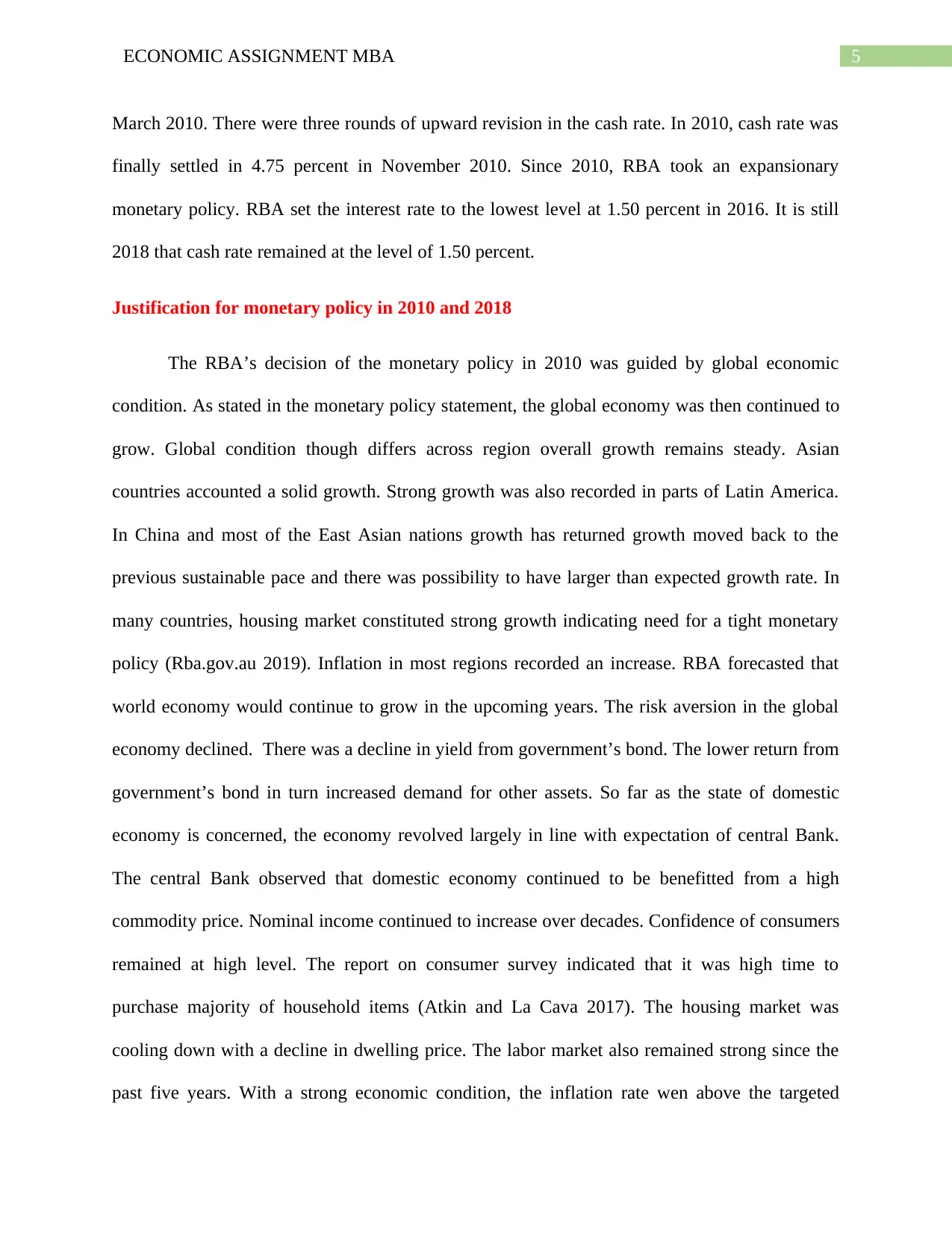
5ECONOMIC ASSIGNMENT MBA
March 2010. There were three rounds of upward revision in the cash rate. In 2010, cash rate was
finally settled in 4.75 percent in November 2010. Since 2010, RBA took an expansionary
monetary policy. RBA set the interest rate to the lowest level at 1.50 percent in 2016. It is still
2018 that cash rate remained at the level of 1.50 percent.
Justification for monetary policy in 2010 and 2018
The RBA’s decision of the monetary policy in 2010 was guided by global economic
condition. As stated in the monetary policy statement, the global economy was then continued to
grow. Global condition though differs across region overall growth remains steady. Asian
countries accounted a solid growth. Strong growth was also recorded in parts of Latin America.
In China and most of the East Asian nations growth has returned growth moved back to the
previous sustainable pace and there was possibility to have larger than expected growth rate. In
many countries, housing market constituted strong growth indicating need for a tight monetary
policy (Rba.gov.au 2019). Inflation in most regions recorded an increase. RBA forecasted that
world economy would continue to grow in the upcoming years. The risk aversion in the global
economy declined. There was a decline in yield from government’s bond. The lower return from
government’s bond in turn increased demand for other assets. So far as the state of domestic
economy is concerned, the economy revolved largely in line with expectation of central Bank.
The central Bank observed that domestic economy continued to be benefitted from a high
commodity price. Nominal income continued to increase over decades. Confidence of consumers
remained at high level. The report on consumer survey indicated that it was high time to
purchase majority of household items (Atkin and La Cava 2017). The housing market was
cooling down with a decline in dwelling price. The labor market also remained strong since the
past five years. With a strong economic condition, the inflation rate wen above the targeted
March 2010. There were three rounds of upward revision in the cash rate. In 2010, cash rate was
finally settled in 4.75 percent in November 2010. Since 2010, RBA took an expansionary
monetary policy. RBA set the interest rate to the lowest level at 1.50 percent in 2016. It is still
2018 that cash rate remained at the level of 1.50 percent.
Justification for monetary policy in 2010 and 2018
The RBA’s decision of the monetary policy in 2010 was guided by global economic
condition. As stated in the monetary policy statement, the global economy was then continued to
grow. Global condition though differs across region overall growth remains steady. Asian
countries accounted a solid growth. Strong growth was also recorded in parts of Latin America.
In China and most of the East Asian nations growth has returned growth moved back to the
previous sustainable pace and there was possibility to have larger than expected growth rate. In
many countries, housing market constituted strong growth indicating need for a tight monetary
policy (Rba.gov.au 2019). Inflation in most regions recorded an increase. RBA forecasted that
world economy would continue to grow in the upcoming years. The risk aversion in the global
economy declined. There was a decline in yield from government’s bond. The lower return from
government’s bond in turn increased demand for other assets. So far as the state of domestic
economy is concerned, the economy revolved largely in line with expectation of central Bank.
The central Bank observed that domestic economy continued to be benefitted from a high
commodity price. Nominal income continued to increase over decades. Confidence of consumers
remained at high level. The report on consumer survey indicated that it was high time to
purchase majority of household items (Atkin and La Cava 2017). The housing market was
cooling down with a decline in dwelling price. The labor market also remained strong since the
past five years. With a strong economic condition, the inflation rate wen above the targeted
⊘ This is a preview!⊘
Do you want full access?
Subscribe today to unlock all pages.

Trusted by 1+ million students worldwide
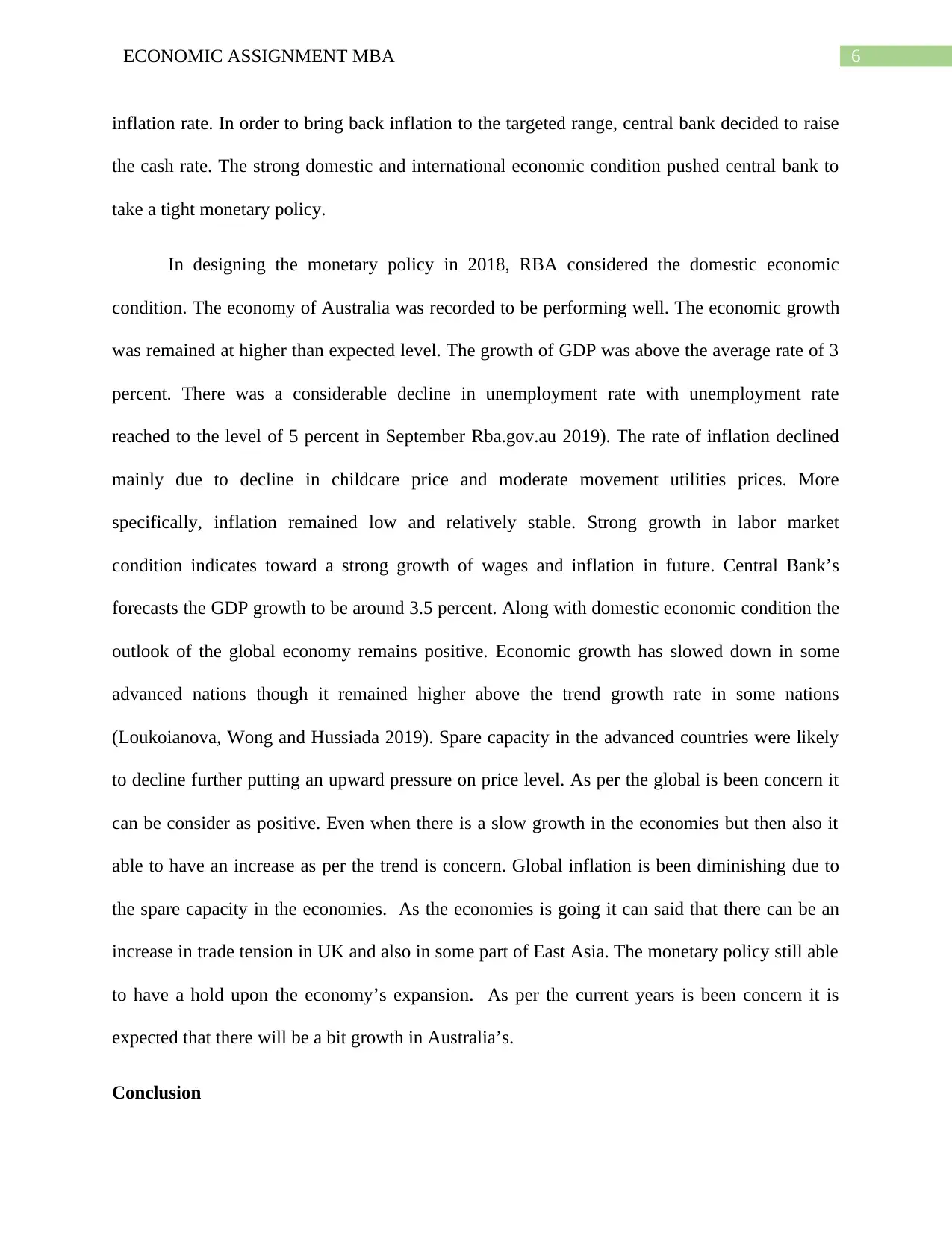
6ECONOMIC ASSIGNMENT MBA
inflation rate. In order to bring back inflation to the targeted range, central bank decided to raise
the cash rate. The strong domestic and international economic condition pushed central bank to
take a tight monetary policy.
In designing the monetary policy in 2018, RBA considered the domestic economic
condition. The economy of Australia was recorded to be performing well. The economic growth
was remained at higher than expected level. The growth of GDP was above the average rate of 3
percent. There was a considerable decline in unemployment rate with unemployment rate
reached to the level of 5 percent in September Rba.gov.au 2019). The rate of inflation declined
mainly due to decline in childcare price and moderate movement utilities prices. More
specifically, inflation remained low and relatively stable. Strong growth in labor market
condition indicates toward a strong growth of wages and inflation in future. Central Bank’s
forecasts the GDP growth to be around 3.5 percent. Along with domestic economic condition the
outlook of the global economy remains positive. Economic growth has slowed down in some
advanced nations though it remained higher above the trend growth rate in some nations
(Loukoianova, Wong and Hussiada 2019). Spare capacity in the advanced countries were likely
to decline further putting an upward pressure on price level. As per the global is been concern it
can be consider as positive. Even when there is a slow growth in the economies but then also it
able to have an increase as per the trend is concern. Global inflation is been diminishing due to
the spare capacity in the economies. As the economies is going it can said that there can be an
increase in trade tension in UK and also in some part of East Asia. The monetary policy still able
to have a hold upon the economy’s expansion. As per the current years is been concern it is
expected that there will be a bit growth in Australia’s.
Conclusion
inflation rate. In order to bring back inflation to the targeted range, central bank decided to raise
the cash rate. The strong domestic and international economic condition pushed central bank to
take a tight monetary policy.
In designing the monetary policy in 2018, RBA considered the domestic economic
condition. The economy of Australia was recorded to be performing well. The economic growth
was remained at higher than expected level. The growth of GDP was above the average rate of 3
percent. There was a considerable decline in unemployment rate with unemployment rate
reached to the level of 5 percent in September Rba.gov.au 2019). The rate of inflation declined
mainly due to decline in childcare price and moderate movement utilities prices. More
specifically, inflation remained low and relatively stable. Strong growth in labor market
condition indicates toward a strong growth of wages and inflation in future. Central Bank’s
forecasts the GDP growth to be around 3.5 percent. Along with domestic economic condition the
outlook of the global economy remains positive. Economic growth has slowed down in some
advanced nations though it remained higher above the trend growth rate in some nations
(Loukoianova, Wong and Hussiada 2019). Spare capacity in the advanced countries were likely
to decline further putting an upward pressure on price level. As per the global is been concern it
can be consider as positive. Even when there is a slow growth in the economies but then also it
able to have an increase as per the trend is concern. Global inflation is been diminishing due to
the spare capacity in the economies. As the economies is going it can said that there can be an
increase in trade tension in UK and also in some part of East Asia. The monetary policy still able
to have a hold upon the economy’s expansion. As per the current years is been concern it is
expected that there will be a bit growth in Australia’s.
Conclusion
Paraphrase This Document
Need a fresh take? Get an instant paraphrase of this document with our AI Paraphraser
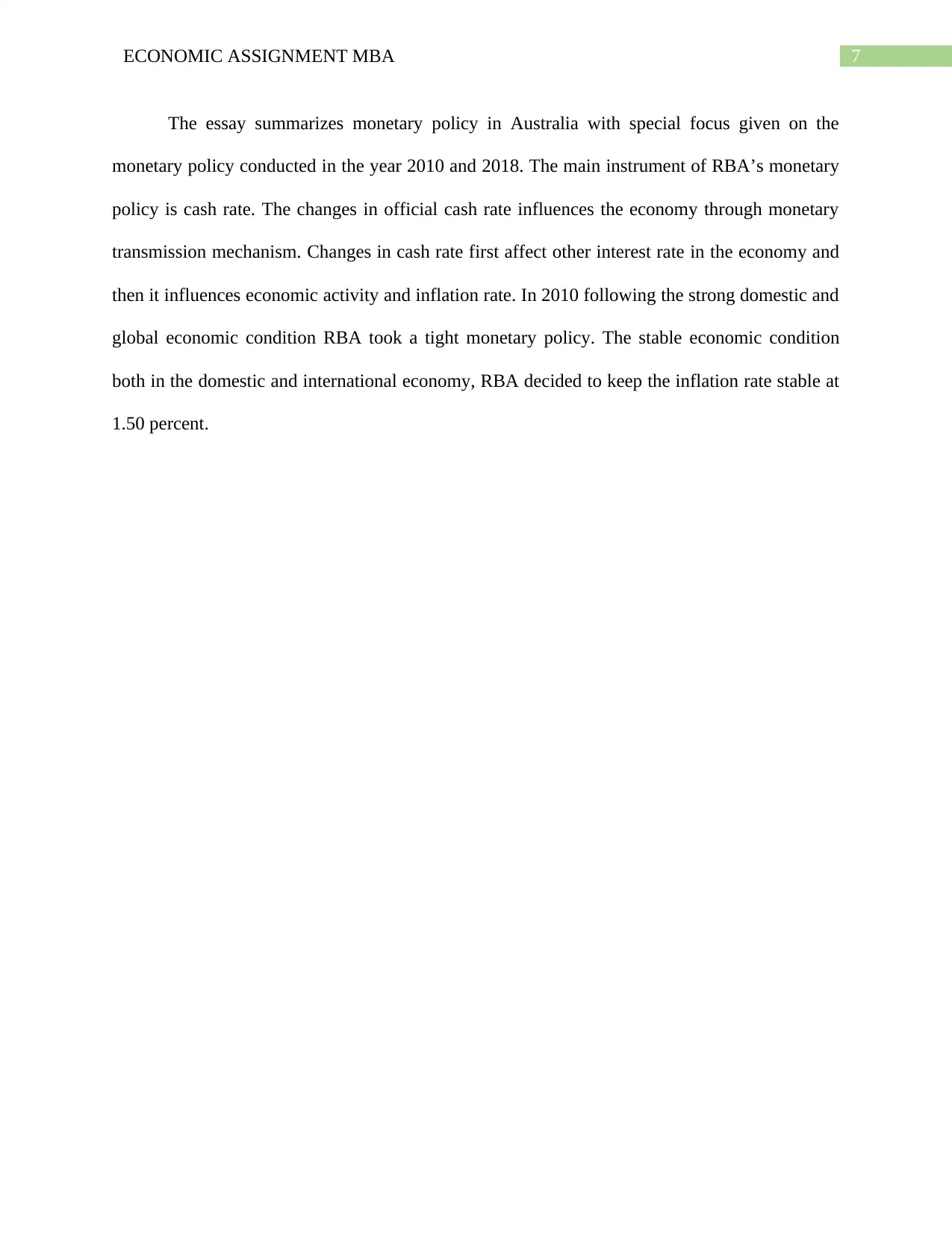
7ECONOMIC ASSIGNMENT MBA
The essay summarizes monetary policy in Australia with special focus given on the
monetary policy conducted in the year 2010 and 2018. The main instrument of RBA’s monetary
policy is cash rate. The changes in official cash rate influences the economy through monetary
transmission mechanism. Changes in cash rate first affect other interest rate in the economy and
then it influences economic activity and inflation rate. In 2010 following the strong domestic and
global economic condition RBA took a tight monetary policy. The stable economic condition
both in the domestic and international economy, RBA decided to keep the inflation rate stable at
1.50 percent.
The essay summarizes monetary policy in Australia with special focus given on the
monetary policy conducted in the year 2010 and 2018. The main instrument of RBA’s monetary
policy is cash rate. The changes in official cash rate influences the economy through monetary
transmission mechanism. Changes in cash rate first affect other interest rate in the economy and
then it influences economic activity and inflation rate. In 2010 following the strong domestic and
global economic condition RBA took a tight monetary policy. The stable economic condition
both in the domestic and international economy, RBA decided to keep the inflation rate stable at
1.50 percent.
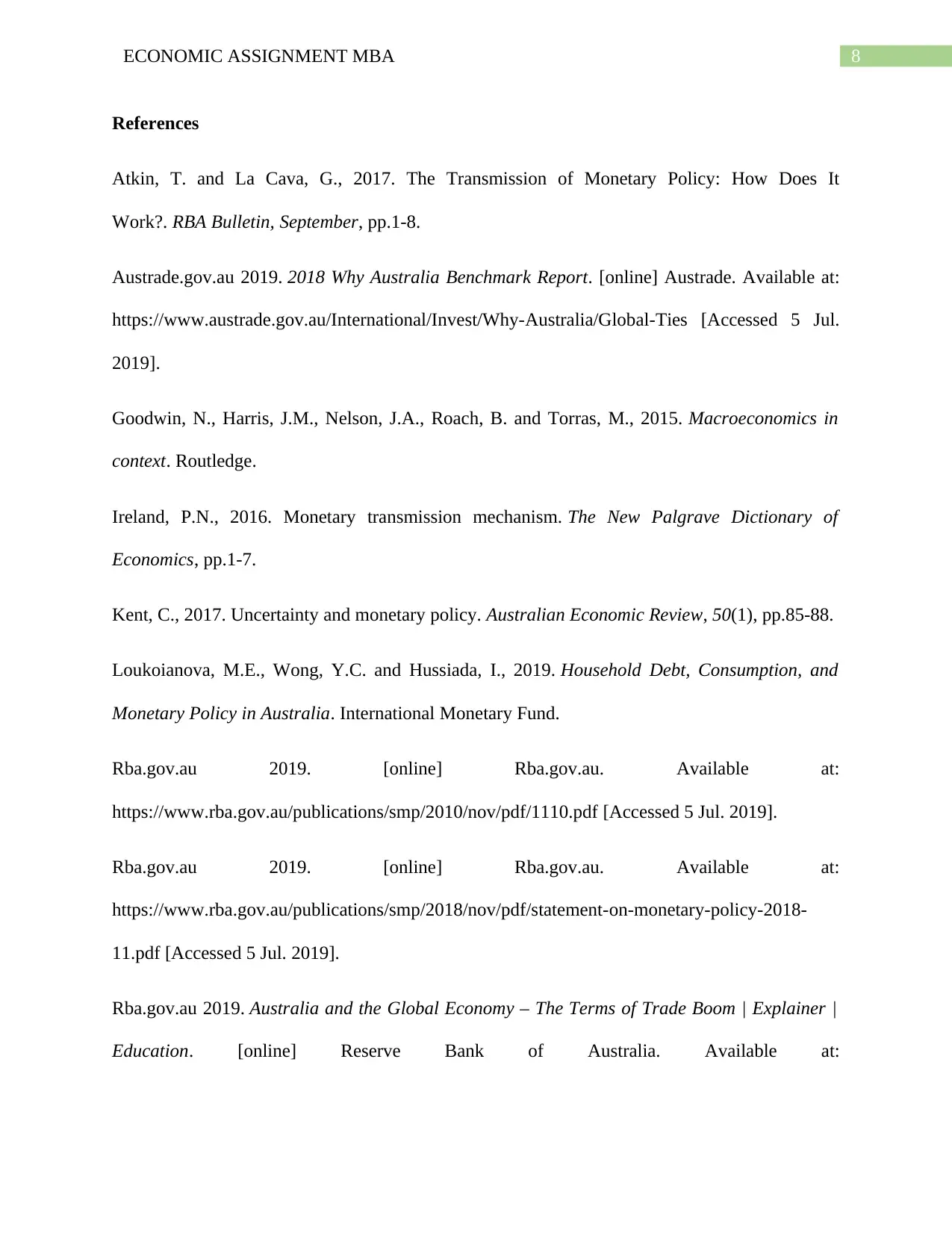
8ECONOMIC ASSIGNMENT MBA
References
Atkin, T. and La Cava, G., 2017. The Transmission of Monetary Policy: How Does It
Work?. RBA Bulletin, September, pp.1-8.
Austrade.gov.au 2019. 2018 Why Australia Benchmark Report. [online] Austrade. Available at:
https://www.austrade.gov.au/International/Invest/Why-Australia/Global-Ties [Accessed 5 Jul.
2019].
Goodwin, N., Harris, J.M., Nelson, J.A., Roach, B. and Torras, M., 2015. Macroeconomics in
context. Routledge.
Ireland, P.N., 2016. Monetary transmission mechanism. The New Palgrave Dictionary of
Economics, pp.1-7.
Kent, C., 2017. Uncertainty and monetary policy. Australian Economic Review, 50(1), pp.85-88.
Loukoianova, M.E., Wong, Y.C. and Hussiada, I., 2019. Household Debt, Consumption, and
Monetary Policy in Australia. International Monetary Fund.
Rba.gov.au 2019. [online] Rba.gov.au. Available at:
https://www.rba.gov.au/publications/smp/2010/nov/pdf/1110.pdf [Accessed 5 Jul. 2019].
Rba.gov.au 2019. [online] Rba.gov.au. Available at:
https://www.rba.gov.au/publications/smp/2018/nov/pdf/statement-on-monetary-policy-2018-
11.pdf [Accessed 5 Jul. 2019].
Rba.gov.au 2019. Australia and the Global Economy – The Terms of Trade Boom | Explainer |
Education. [online] Reserve Bank of Australia. Available at:
References
Atkin, T. and La Cava, G., 2017. The Transmission of Monetary Policy: How Does It
Work?. RBA Bulletin, September, pp.1-8.
Austrade.gov.au 2019. 2018 Why Australia Benchmark Report. [online] Austrade. Available at:
https://www.austrade.gov.au/International/Invest/Why-Australia/Global-Ties [Accessed 5 Jul.
2019].
Goodwin, N., Harris, J.M., Nelson, J.A., Roach, B. and Torras, M., 2015. Macroeconomics in
context. Routledge.
Ireland, P.N., 2016. Monetary transmission mechanism. The New Palgrave Dictionary of
Economics, pp.1-7.
Kent, C., 2017. Uncertainty and monetary policy. Australian Economic Review, 50(1), pp.85-88.
Loukoianova, M.E., Wong, Y.C. and Hussiada, I., 2019. Household Debt, Consumption, and
Monetary Policy in Australia. International Monetary Fund.
Rba.gov.au 2019. [online] Rba.gov.au. Available at:
https://www.rba.gov.au/publications/smp/2010/nov/pdf/1110.pdf [Accessed 5 Jul. 2019].
Rba.gov.au 2019. [online] Rba.gov.au. Available at:
https://www.rba.gov.au/publications/smp/2018/nov/pdf/statement-on-monetary-policy-2018-
11.pdf [Accessed 5 Jul. 2019].
Rba.gov.au 2019. Australia and the Global Economy – The Terms of Trade Boom | Explainer |
Education. [online] Reserve Bank of Australia. Available at:
⊘ This is a preview!⊘
Do you want full access?
Subscribe today to unlock all pages.

Trusted by 1+ million students worldwide
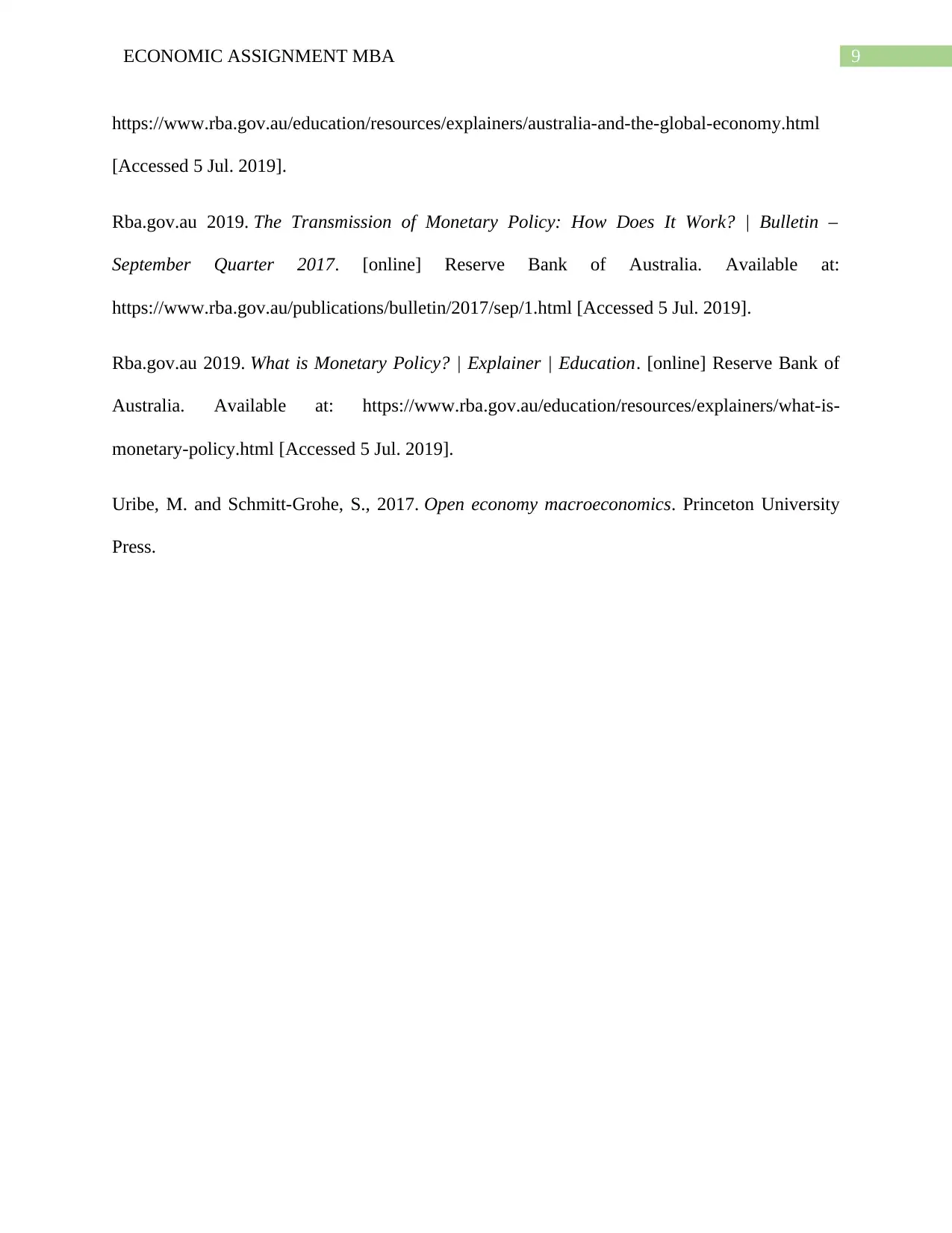
9ECONOMIC ASSIGNMENT MBA
https://www.rba.gov.au/education/resources/explainers/australia-and-the-global-economy.html
[Accessed 5 Jul. 2019].
Rba.gov.au 2019. The Transmission of Monetary Policy: How Does It Work? | Bulletin –
September Quarter 2017. [online] Reserve Bank of Australia. Available at:
https://www.rba.gov.au/publications/bulletin/2017/sep/1.html [Accessed 5 Jul. 2019].
Rba.gov.au 2019. What is Monetary Policy? | Explainer | Education. [online] Reserve Bank of
Australia. Available at: https://www.rba.gov.au/education/resources/explainers/what-is-
monetary-policy.html [Accessed 5 Jul. 2019].
Uribe, M. and Schmitt-Grohe, S., 2017. Open economy macroeconomics. Princeton University
Press.
https://www.rba.gov.au/education/resources/explainers/australia-and-the-global-economy.html
[Accessed 5 Jul. 2019].
Rba.gov.au 2019. The Transmission of Monetary Policy: How Does It Work? | Bulletin –
September Quarter 2017. [online] Reserve Bank of Australia. Available at:
https://www.rba.gov.au/publications/bulletin/2017/sep/1.html [Accessed 5 Jul. 2019].
Rba.gov.au 2019. What is Monetary Policy? | Explainer | Education. [online] Reserve Bank of
Australia. Available at: https://www.rba.gov.au/education/resources/explainers/what-is-
monetary-policy.html [Accessed 5 Jul. 2019].
Uribe, M. and Schmitt-Grohe, S., 2017. Open economy macroeconomics. Princeton University
Press.
1 out of 10
Related Documents
Your All-in-One AI-Powered Toolkit for Academic Success.
+13062052269
info@desklib.com
Available 24*7 on WhatsApp / Email
![[object Object]](/_next/static/media/star-bottom.7253800d.svg)
Unlock your academic potential
Copyright © 2020–2025 A2Z Services. All Rights Reserved. Developed and managed by ZUCOL.





